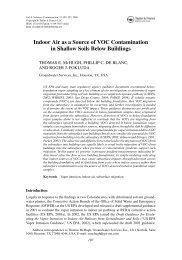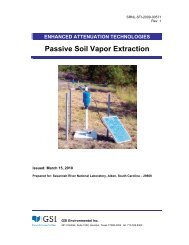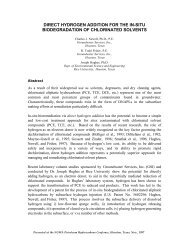as k point) , derived from single well concentration vs. time plot, maybe used to determine how long a plume will persist (PlumeDuration). While concentration vs. time data at a single point inthe plume are useful <strong>for</strong> determining trends at that location (i.e.,are concentrations increasing, showing relatively little change, ordeclining), a rate constant calculated from concentration vs. timedata at a single location cannot be used to estimate the trend <strong>of</strong>an entire plume.Bulk attenuation rates (defined as k), derived from concentrationvs. distance plots, can be used to indicate if a plume is exp<strong>and</strong>ing,showing relatively little change, or shrinking (Plume Trends).Biodegradation rates ( λ ), modeling parameters which arespecific to biodegradation effects <strong>and</strong> exclusive <strong>of</strong> dispersion, etc.,can be used in appropriate solute transport models to indicate ifa plume is exp<strong>and</strong>ing, showing relatively little change, or shrinking(Plume Trends).For each <strong>of</strong> these first-order decay rate parameters, Table 2summarizes in<strong>for</strong>mation on the derivation <strong>and</strong> appropriate useas well as providing representative values. In summary, differenttypes <strong>of</strong> first-order attenuation rate calculations are available tohelp evaluate natural attenuation processes at contaminatedground-water sites. These different types <strong>of</strong> rate constantsrepresent different types <strong>of</strong> attenuation processes, there<strong>for</strong>e, theright type <strong>of</strong> rate constant should be used <strong>for</strong> the right purpose.Examples 1-3 illustrate how the three types <strong>of</strong> rate constants arecalculated <strong>and</strong> applied.Key Point:In general, all three types <strong>of</strong> rate constants are useful indicatorsthat attenuation is occurring. Concentration vs. time rate constants( k point) can be used to estimate the duration <strong>of</strong> contamination at aparticular location. Concentration vs. time rate constants <strong>for</strong> wellsencompassing the entire plume can be used to identify overalltrends <strong>and</strong> predict the duration <strong>of</strong> the plume. Concentration vs.distance rate constants ( k ) <strong>and</strong> biodegradation rate constants( λ ) can be used to project the rate <strong>of</strong> attenuation <strong>of</strong> contaminantsalong the flow path in ground water, <strong>and</strong> predict the spatial extent<strong>of</strong> the plume.Tables 1 <strong>and</strong> 2 provide more detail on use, calculations, <strong>and</strong>analysis <strong>of</strong> the three types <strong>of</strong> rate constants. Examples 1-3illustrate the use <strong>and</strong> application <strong>of</strong> the three types <strong>of</strong> rateconstants.Other Types <strong>of</strong> <strong>Rate</strong> <strong>Constants</strong>Mass-Based <strong>Rate</strong> <strong>Constants</strong>. The previous discussion focusedon concentration-based rates. It is also possible to calculate massvs. time rate constants <strong>and</strong> mass vs. distance rate constants. Inpractice, these rates would be very similar to the concentrationbasedrates.Mass vs.Time <strong>Rate</strong> Constant. This constant compares changesin the total mass <strong>of</strong> contaminants in the plume over time. AThiessen polygon network can be used to weight the concentrationdata from all the available wells at a site to derive a comprehensiveestimate <strong>of</strong> the mass <strong>of</strong> contaminants in the plume at any particularround <strong>of</strong> sampling. Mass vs. time decay rates (in units <strong>of</strong> inversetime) are estimated by plotting the natural log <strong>of</strong> total dissolvedmass as a function <strong>of</strong> time <strong>and</strong> estimating the slope <strong>of</strong> the line.This rate is similar to the concentration vs. time rate <strong>and</strong> since itaccounts <strong>for</strong> the entire plume, it is a good indicator <strong>of</strong> how long aplume will persist. Many plumes change flow direction over time,making it difficult to identify a stable centerline. Estimates basedon the entire plume are less subject to errors caused by changesin flow direction. See Hyman <strong>and</strong> DuPont, 2001 <strong>and</strong> DuPont etal.,1998 <strong>for</strong> discussion <strong>and</strong> details <strong>of</strong> the methods.Mass Flux vs. Distance <strong>Rate</strong> Constant. A mass vs. distancedecay rate (in units <strong>of</strong> inverse time) can be calculated by plottingthe natural log <strong>of</strong> mass flux through different transectsperpendicular to the flow as a function <strong>of</strong> distance from the source<strong>and</strong> multiplying the slope <strong>of</strong> the best-fit line by the seepage velocity.Comparable to the bulk attenuation rate, this type <strong>of</strong> rate can beused to indicate if a plume is exp<strong>and</strong>ing, showing relatively littlechange, or shrinking. See Einarson <strong>and</strong> Mackay, 2001 <strong>for</strong>examples <strong>of</strong> mass flux calculations. Another method <strong>for</strong> calculatingmass loss rates is described by the Remediation TechnologiesDevelopment Forum (RTDF, 1997).Mass Flux-Based Biodegradation <strong>Rate</strong> Constant. Mass fluxesacross plume transects can be further analyzed to determinewhether the observed mass loss spatially <strong>and</strong> temporally can beattributed to biodegradation <strong>and</strong>/or source decay. For this purpose,the mass flux across the source area is compared to the massflux through the next downgradient section. Theoretically, massfluxes at the downgradient transect should mimic the trendsobserved in the source transect if source decay, sorption, <strong>and</strong>dispersion were the only mass reduction attenuation mechanisms.If there is additional mass loss, it can only be attributed tobiodegradation since the other processes are already accounted<strong>for</strong> in the mass flux calculation. Once the actual mass lossattributable to biodegradation has been determined, it is plottedas a function <strong>of</strong> time <strong>and</strong> a biodegradation rate is estimated usinglinear regression or a first-order decay model fit to the data. SeeBorden et al. (1997) <strong>and</strong> Semprini et al. (1995) <strong>for</strong> examples <strong>of</strong>biodegradation rates calculated from mass flux across transects.Mass-based rate constants are not <strong>of</strong>ten used in practice due tothe data needs <strong>for</strong> mass estimates including a dense well networkas well as localized gradients, conductivity measurements, <strong>and</strong>aquifer thickness at monitoring points.Average-Plume Concentration <strong>Rate</strong> <strong>Constants</strong>. Some researchers<strong>and</strong> practitioners have calculated rate constants <strong>for</strong> the changein average plume concentration. This rate constant reflectsprimarily the change in source strength over time.Effect <strong>of</strong> Residual NAPL on Point Decay <strong>Rate</strong>ConstantWhen a monitoring well is screened across an interval thatcontains residual NAPL, <strong>and</strong> when the rate <strong>of</strong> weathering <strong>of</strong> theNAPL is slow, the well water may sustain high concentrations <strong>of</strong>contaminants over long periods <strong>of</strong> time.Effect <strong>of</strong> NA Processes on <strong>Rate</strong> <strong>Constants</strong>Natural attenuation processes include a variety <strong>of</strong> physical,chemical, or biological processes that act without humanintervention to reduce the mass or concentration <strong>of</strong> contaminantsin soil <strong>and</strong> ground water. These in-situ processes includebiodegradation, dispersion, dilution, sorption, volatilization,radioactive decay, <strong>and</strong> chemical or biological stabilization,trans<strong>for</strong>mation, or destruction <strong>of</strong> contaminants (U.S. EPA, 1999).Each <strong>of</strong> these processes influences contaminant concentrationsin soil <strong>and</strong> ground water both spatially <strong>and</strong> temporally at a site.Contaminant concentrations in ground water are reduced as theytravel downgradient from the source. Subject to sourcedegradation, contaminant concentrations will also be reduced withtime at any given distance downgradient from the source. Theseconcepts are illustrated in Appendices II <strong>and</strong> III. The data inAppendix II illustrate the change in contaminant concentrationsdowngradient from the source at a hypothetical site in response4
to the different attenuation processes. It can be clearly seen fromAppendix II that contaminant concentrations downgradient fromsource areas are attenuated due to dispersion, sorption,biodegradation <strong>and</strong> source decay.The data in Appendix III illustratethe change in contaminant concentrations with time at two pointsdowngradient from the source at the hypothetical site (one pointnear the source <strong>and</strong> the other point at the leading edge <strong>of</strong> theplume). As can be seen from Appendix III, contaminantconcentrations near the source will attenuate with time only ifsource decay is occurring. While source decay is also important<strong>for</strong> the leading edge <strong>of</strong> the plume, maximum contaminantconcentrations in that zone are significantly attenuated from theirsource concentration counterparts due to biodegradation,sorption, <strong>and</strong> dispersion.Uncertainty in <strong>Rate</strong> <strong>Calculation</strong>s<strong>Rate</strong> calculations can be affected by uncertainty from a number<strong>of</strong> sources, such as the design <strong>of</strong> the monitoring network, seasonalvariations, uncertainty in sampling methods <strong>and</strong> lab analyses,<strong>and</strong> the heterogeneity in most ground-water plumes. Appendix Idiscusses uncertainty in rate calculations <strong>and</strong> provides methods<strong>for</strong> managing this uncertainty.ORD has developed s<strong>of</strong>tware (RaCES) to extract rate constantsfrom field data. This s<strong>of</strong>tware is intended to facilitate an evaluation<strong>of</strong> the uncertainty associated with the projections made bycomputer models <strong>of</strong> the future behavior <strong>of</strong> plumes <strong>of</strong> contaminationin ground water. The s<strong>of</strong>tware is available from The EcosystemResearch Division <strong>of</strong> the National Exposure Research Laboratoryin Athens, Georgia (Budge et al., 2003).NoticeThe U.S. Environmental Protection Agency through its Office <strong>of</strong>Research <strong>and</strong> Development funded <strong>and</strong> managed the researchdescribed here under Contract No. 68-C-99-256 to DynamacCorporation. It has been subjected to the Agency’s peer <strong>and</strong>administrative review <strong>and</strong> has been approved <strong>for</strong> publication asan EPA document. Mention <strong>of</strong> trade names or commercialproducts does not constitute endorsement or recommendation<strong>for</strong> use.Quality Assurance StatementAll research projects making conclusions or recommendationsbased on environmental data <strong>and</strong> funded by the U.S.Environmental Protection Agency are required to participate inthe Agency Quality Assurance Program. This project did notinvolve the collection or use <strong>of</strong> environmental data <strong>and</strong>, as such,did not require a Quality Assurance Project Plan.5






